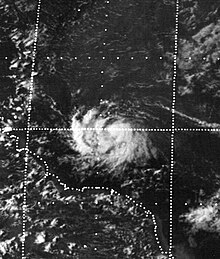 Tropical Storm Alma at peak intensity on August 13 | |
| Meteorological history | |
|---|---|
| Formed | August 12, 1974 |
| Dissipated | August 15, 1974 |
| Tropical storm | |
| 1-minute sustained (SSHWS/NWS) | |
| Highest winds | 65 mph (100 km/h) |
| Lowest pressure | 1007 mbar (hPa); 29.74 inHg |
| Overall effects | |
| Fatalities | 51 total |
| Damage | $5 million (1974 USD) |
| Areas affected | Trinidad and Tobago, Venezuela |
| IBTrACS | |
Part of the 1974 Atlantic hurricane season | |
Tropical Storm Alma, the first named storm to develop in the 1974 Atlantic hurricane season, was a short lived tropical cyclone that made a rare Venezuelan landfall. The storm formed from the Intertropical Convergence Zone (ITCZ) on August 12 well to the east of the Windward Islands, but advisories were not issued until the next day when Alma was at peak intensity. Alma entered the southeastern Caribbean Sea at an unusually brisk westward pace of between 20 mph (32 km/h) to 25 mph (40 km/h), prompting numerous watches and gale warnings throughout the nations in this region. After crossing Trinidad, Alma became one of only four tropical storms to traverse the Paria Peninsula of northeastern Venezuela. The storm dissipated on August 15 over the high terrain of Venezuela.
Alma left heavy damage in Trinidad, amounting to about US$5 million (value in 1974), making it the most destructive cyclone of the 20th century on the island at that time. Alma damaged about 5,000 buildings, leaving 500 people homeless. The storm also wrecked 17,750 acres (7,180 ha) of crop fields. There were two deaths in Trinidad, including one person who was struck by flying debris. Alma's heavy rainfall was responsible for a plane crash on Isla Margarita off the Venezuelan coast, killing the 49 people on board.